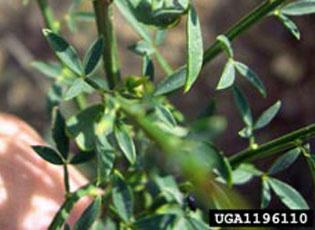Cytisus scoparius (L.) Link (ITIS)
Scotch broom, broomtops, common broom, European broom, Irish broom, English broom
Europe and North Africa (Zouhar 2005)
1800s (Zouhar 2005)
Introduced as an ornamental or possibly as livestock fodder (Mack 2003; Zouhar 2005)
Forms dense stands which crowd out native species and destroy wildlife habitat (Zouhar 2005)

Scotch broom, foliage in Alaska
Photo by Tom Heutte; USDA, Forest Service
Find more images
Spotlights
Distribution / Maps / Survey Status
All Resources
Selected Resources
The section below contains highly relevant resources for this species, organized by source.
Council or Task Force
Partnership
Federal Government
International Government
State and Local Government
Academic
Integrated Taxonomic Information System. Cytisus scoparius. [Accessed Sep 22, 2023].
Mack, R.N. 2003. Plant naturalizations and invasions in the eastern United States: 1634-1860. Annals of the Missouri Botanical Garden 90(1):77-90.
Zouhar, K. 2005. Cytisus scoparius, C. striatus. In: Fire Effects Information System. U.S. Department of Agriculture, Forest Service, Rocky Mountain Research Station, Fire Sciences Laboratory.
